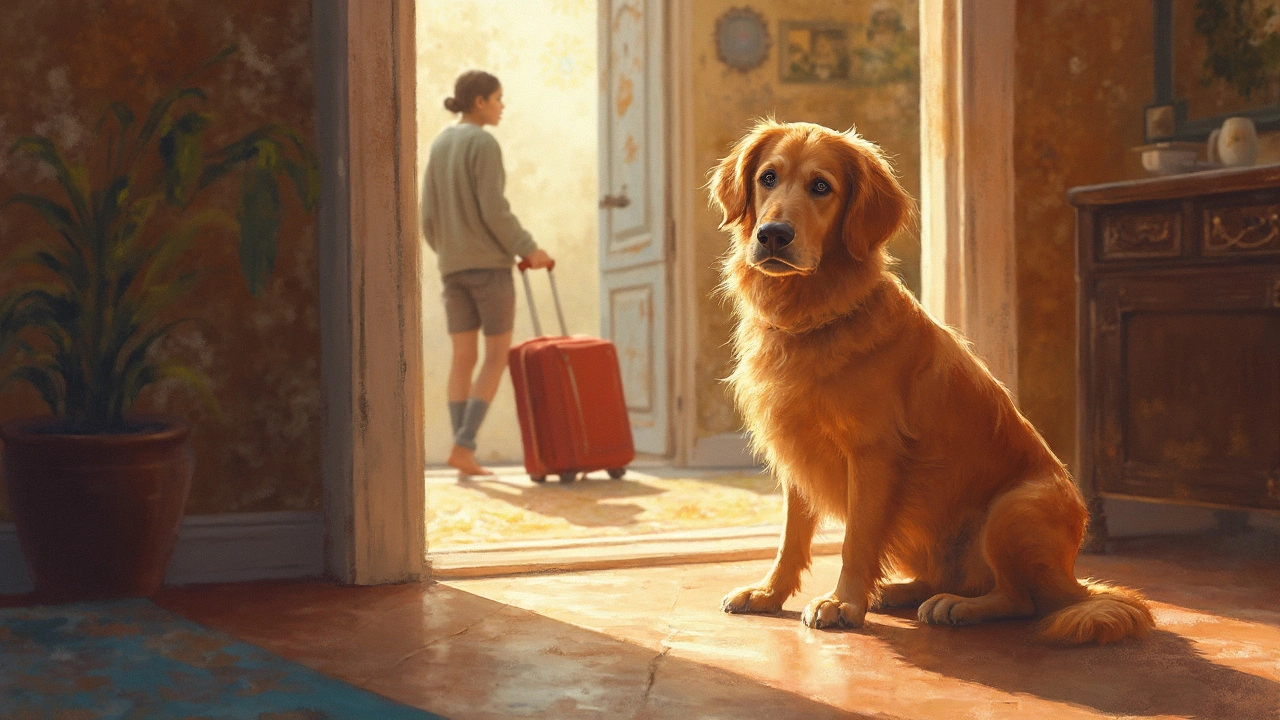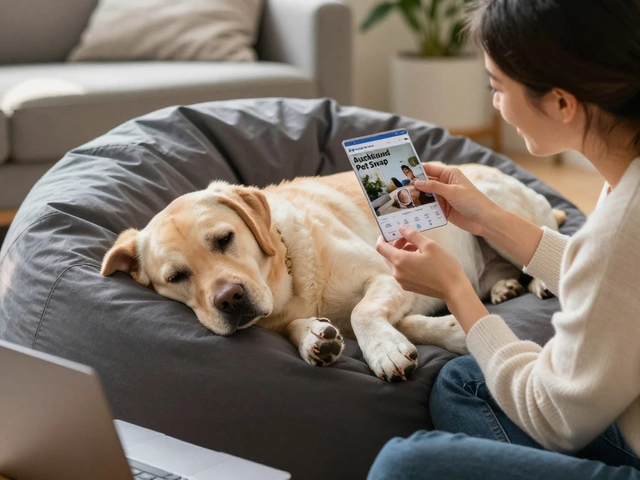
Ever wondered if your dog knows you're about to head out on a trip? You're not alone. Many dog owners are curious if their furry friends pick up on those little cues we unknowingly give away—like packing a suitcase or the odd rituals we do before leaving home. But what’s the real deal?
First off, dogs are super smart when it comes to reading human behavior. They notice a lot more than we often give them credit for. Those apparent innocent changes in your routine? Your dog’s on it, picking up the vibe that something's up. It's kinda like when you start putting on your shoes, and boom, they're at the door, ready for a walk. They’ve got that instinctive knack for recognizing patterns.
And when it comes to leaving for a holiday, some dogs might act differently. Maybe they’re unusually clingy, or suddenly not as playful. That’s because they sense a change, even if they're not entirely sure what it means. Understanding these behaviors is crucial—because a bit of preparation can make a world of difference to their well-being when you’re away.
- Understanding Dog Emotions
- Signs Your Dog Knows You're Leaving
- Why Some Dogs React Differently
- Preparing Your Pup for Your Absence
- Creating a Calm Environment
- Choosing Dog-Friendly Travel Options
Understanding Dog Emotions
Let’s dig into how dogs feel and express their emotions. Believe it or not, dogs experience a wide range of feelings, much like humans. You’ve probably noticed your pup's joy during playtime or their sad eyes when you leave home. But what’s really fascinating is how they process these emotions and use them to understand their world—including when you're about to leave for a trip.
Dogs have a complex emotional life, despite lacking complex verbal skills. They express joy with a wagging tail or their unique happy dance, and might show fear by cowering or trembling. Ever notice them giving you puppy eyes before you head to work? That's their way of communicating distress, hoping you'll stick around a little longer. Emotions like envy or anticipation are also in their repertoire.
Studies have shown that dogs can pick up on their owner’s emotions, a skill honed through thousands of years of cohabitation. This developed sense of empathy isn't just about knowing when you're about to leave; it's about understanding the vibe you're giving off. If packing makes you stressed, they might mirror that anxiety, leading to behaviors like nervous pacing or excessive barking.
Understanding these emotional capabilities goes a long way in preparing for a trip. Knowing how dogs process such cues helps owners create an environment that minimizes anxiety. Simply sticking to familiar routines before leaving can give your pup a sense of stability.
Signs Your Dog Knows You're Leaving
Ever notice your pup acting all weird when you're about to leave for a trip? It’s not just in your head. Dogs are wired to pick up on various behaviors and changes around them, especially those involving their humans. You might find your dog following you around a bit more or watching you closely from their comfy spot as soon as you start packing.
One big sign is when your dog becomes extra clingy. Like, they suddenly can't get enough of being around you. This heightened affection often means they’re aware something's changing, like you packing your bags or suddenly choosing clothes that are more 'airport friendly'. Their ability to pick up on these patterns is incredible.
Other times, your dog might get a bit anxious. Some dogs might pace, whine, or even sit by the door. It's their way of showing they're clued into the fact you're gearing up to leave. And don't blame them—they want to be sure you’re not heading to the park without them!
Let's not forget about bags—yeah, dogs have an eye for bags. Maybe your dog hangs around your suitcase like it’s going to magically help them jump in. They've learned from experience that a suitcase often equals their humans being gone for a while.
Here’s a quick checklist of what to look for:
- Increased clinginess: Staying close by your side, more cuddles.
- Change in mood: Downcast, less playful.
- Monitoring movement: Following you from room to room.
- Vocalizing: Whining or barking more than usual.
- Recognizing travel preparations: Bags, clothes, shoes.
Any of these sound familiar? Recognizing these signs can help ease the transition for both you and your beloved pet when it’s time for a getaway.
Why Some Dogs React Differently
Ever notice how some dogs are totally chill when you leave, while others act like you're heading to Mars forever? It's kinda fascinating, really. The way dogs react to us leaving can depend on a bunch of factors—like their breed, past experiences, and even their current environment.
Take, for example, certain breeds like Border Collies or German Shepherds. These guys have a strong bond with their humans and can be more prone to anxiety when they sense a trip on the horizon. That's because they're super loyal and feel a stronger disruption in their little world when you’re not around.
On the flip side, some dogs might have had experiences early in life that affect how they handle these situations. If your dog has been through some rough patches like being rehomed or dealing with neglect, they might act more anxious when change is afoot. It can bring up stress because they remember what it was like without you.
- Dog Behavior: Observing their body language can be key. Look for signs like pacing, whining, or even hiding.
- Past Experiences: How they coped with separation in the past can predict current behavior.
- Divergent Reactions: While some dogs might sulk, others may act out to capture your attention.
Interestingly, life events impact dogs too. Big changes, like moving to a new home or introducing a new pet, can make them more sensitive. They might link travel with pets to these big shifts, causing them to react more strongly.
So, what can you do? Understanding your dog’s unique background and quirks can help you prepare them—and yourself—better. Helping your furry buddy cope with your absence can mean peace of mind for both of you when you're off on your adventure.

Preparing Your Pup for Your Absence
Leaving your dog behind, whether for a short trip or a long vacation, can be tough on both your furry friend and you. But there are some neat ways to ease that stress and make the transition smoother.
First, try to establish a departure routine your dog can understand. Start it a day or two before the trip, so it gives them time to adjust. Like, if you usually pack a suitcase last minute, do it gradually over a few days instead. This way, your pup doesn't get all anxious seeing bags come out of nowhere.
Setting up a comforting space is another pro move. Make sure they've got their favorite toys, a cozy bed, and maybe an unwashed item of your clothing for your scent. Familiar things can work wonders in keeping them calm.
Communication is key, even if it seems like a one-way thing. Talk to your pup, explaining that you'll be gone for a bit but will be back. Use a calming tone—dogs are ace at picking up on feelings and reassurance in your voice.
Consider using technology to stay connected. Pet cameras that let you see and talk to your dog can help maintain that bond, even from afar.
If you'll be away for a long while, think about enlisting help. A pet sitter or boarding facility that suits your pup's needs can be a game-changer. Make sure they're familiar with the setup and routines well before the trip.
The ultimate goal is to keep things as routine as possible. Dogs thrive on it, and they'll feel more secure when life stays predictable, even in your absence.
Creating a Calm Environment
Your dog feeling uneasy when you're getting ready for a holiday? It's totally normal. The key to making this transition smoother is to establish a chill vibe at home, which can totally help ease their nerves while you're away.
Start by making sure your pooch's favorite chill-out spots are easily accessible. You know, those comfy corners where they love to nap or do a little people-watching. Stock these areas with their fave toys and blankets. A familiar scent is like a warm hug, letting them know everything's gonna be alright.
Speaking of scents, consider using calming pheromone diffusers. They're not magic but pretty close! These diffusers mimic a natural calming pheromone, which has been shown to lower anxiety levels in many dogs. It's like hugging them with pheromones, basically.
Now, those dogs who seem to have a sixth sense might benefit from a solid background noise. Leave the radio or TV on at a low volume. The gentle hum can mask unfamiliar sounds from outside and keep their surroundings feeling predictable. It's all about keeping things familiar in your absence.
Depending on your dog's personality, it might also be useful to engage a pet sitter or a neighbor for occasional visits. This human interaction can break up their day and provide some mental stimulation, making your absence a bit more manageable.
Here's another pro tip: practice short departures before your actual trip. Head out for a few hours and gauge their reaction. This way, leaving is less dramatic, and they can gradually adjust to being alone for extended periods.
For some dogs, extra comfort might come in the form of a travel with pets option. Evaluate your plans and see if they can tag along. If not, prepping their environment to be a soothing sanctuary while you're gone is the next best thing. With a bit of forethought, you can make leaving them behind a gentle, stress-free experience.
Choosing Dog-Friendly Travel Options
Planning a trip with your furry buddy? Awesome! But before you hit the road or the skies, it's crucial to make sure you're picking the right travel options that are truly dog-friendly. No one wants to deal with surprise fees or restrictions at the last minute.
First, let’s talk about accommodations. Not every hotel or Airbnb rolls out the red carpet for pets, but lots do! Websites like BringFido or Petswelcome can hook you up with places that don't just allow dogs but love them. Remember, checking the fine print about pet policies (like size limits or extra charges) always pays off.
When it comes to transportation, airlines have different guidelines for traveling with pets. Some allow small dogs in the cabin, while others only have options for cargo travel. Always check in advance. For car trips, a cozy dog seat cover or a travel crate can make the journey much smoother. Plus, it keeps your pup safe during sudden stops or sharp turns.
Planning fun activities? Plenty of destinations offer dog-friendly attractions like parks, trails, and beaches. A quick search for dog parks or pet-friendly events can fill your itinerary with options that your dog will wag its tail for.
| Transportation Type | Pet Policy Insight |
|---|---|
| Airlines | Check individual airline policies; cabin or cargo options available |
| Trains | Like Amtrak in the U.S., permits small pets on certain routes & larger carriers |
| Rental Cars | Confirm with rental companies; bring covers or blankets |
Ultimately, the idea is to ensure your dog’s comfort and safety while you enjoy your vacation. With the right prep, both you and your pet can have a memorable journey!


